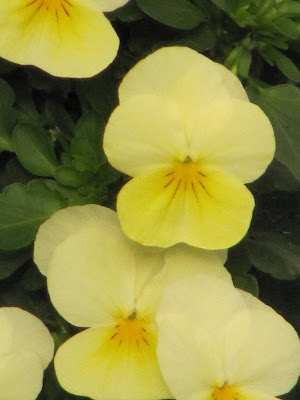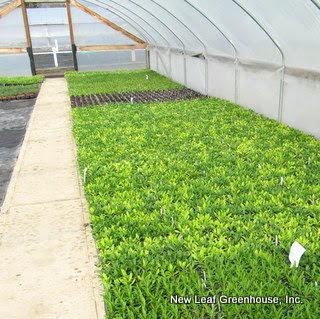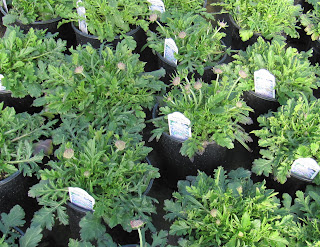
Here in western Oregon and Washington we have nearly perfect conditions to enjoy beautiful fuchsia hanging baskets all summer long. They require a bit more effort than other shade hanging baskets such as impatiens, but nothing is more satisfying than keeping those flowers coming. Three factors influence how your fuchsia basket will perform during the summer months - fertilization, pinching, and location. And of course, fuchsias need lots of water.
Fuchsias are best under high shade of trees. Don't place your fuchsia basket too far back under an eave, and don't hang your fuchsia basket on the west side of your home unless there is shade from trees or porches from 1:00 PM to 4:00 PM. Some direct sun in the morning is fine for most varieties. When we do get extremely hot weather over 90 degrees, look for a cool and shady place to place your fuchsia basket until the weather moderates. If strong winds come with hot weather, fuchsias are especially at risk. The best place for them then is in a shady, protected corner of the garden - maybe on old chair or inverted bucket.

Here's a nice, full basket of the fuchsia variety Lena. It's an old standard, and fairly winter hardy as well. For purposes of my blog - and horticulture in general - the word "hardy" specifically mean that frost will not kill or injure the plant. Hardy fuchsias planted in the ground may die back - and indeed should be cut back hard in late September - but their crown and roots will survive to bring flowers in the coming year.
I like to see layers of flowers and buds in a well grown fuchsia, like the Lena basket. I don't want it to be too far along when I purchase it or many flowers will be lost in transport.

This Lena basket has a full top, which means more flowers ahead.
Fertilizing fuchsias is very important. They are heavy feeders, and keeping new flowers coming requires continued growth of the plant. Here are some basics for feeding your fuchsia. Most importantly, never feed your fuchsia, or any other plant, if the plant shows any sign of wilt. Burning of roots and foliage can take place, and buds will drop. The best way to feed fuchsias is to feed at a low rate with each watering. I like to purchase a 2-1/2 gallon plastic bucket, and keep my fertilizer right in the bucket near my water tap. Each time I need to water my fuchsia, I fill the bucket of water and then add the quantity of fertilizer recommended for 1 gallon of water to my 2-1/2 gallon bucket. That gives me a nice 1/2 strength solution that is just right for every-watering use.

The kind of fertilizer you use isn't nearly as important that you use fertilizer regularly. If you are not seeing new buds, and if your fuchsia basket has a thinned and patchy look, it is probably hungry. Time release fertilizer, such as osmocote, can be used to supplement liquid feeing at the package rate. We use it on all our big baskets here at New Leaf Greenhouse.

Most fuchsia varieties have distinctive growth habits. Some are stiff, and others are weeping. My personal favorite is Jack Shahan, which you see here. It is a single rose pink self - both petals and corolla are the same color of rose - but it is prolific of bloom and makes a beautifully formed wide basket over the course of the summer.

Swingtime is one of the most popular fuchsias in cultivation. It is also an old variety, and makes a very nice large shrub at the Oregon Coast, where winters do not kill it back to the ground. It makes a wide and generous basket, but will be woody and stiff if not fertilized adequately. In the ground, it is both upright and hardy, in spite of its' popularity as a hanging basket plant.

Here's the lovely flower of Dark Eyes, which has a classic draping fuchsia basket form.
Now - the pinching. Flowers are only borne on new shoots, and to keep those shoots coming, branch tips must be regularly removed by pinching. All you have to do is pinch out the last 1/2" of the stem, taking out the last tiny pair of leaves. Each week, you need to pinch out 1/6 of all the tips around your basket, and especially on the top of your basket.
This is magic! Provided that your plant is adequately fertilized, watered, and protected from wind and heat, you will have a steady succession of flower buds on new growth all summer. Commercial growers of fuchsias know how to time their baskets for Mothers' Day - stop pinching late March. It takes just six weeks for fuchsia buds to form and flower after a pinch, and when you pinch 1/6th of your tips out each week, you are assuring new buds and flowers every week, all summer.

These Rocket Fire flowers are crazy big, nearly 5 inches across. Plants with monster flowers like Rocket Fire sometimes have fewer flowers than those with smaller, or single flowers, like Jack Shahan. One of my favorite fuchsias, Auntie Jinks, is the last to bloom but has hundreds of small purple and white flowers in gracefully layered foliage. Simply lovely!

Here's a photo of the fuchsia variety Blackie, every grower's worst nightmare. Customers love it, but it's nearly impossible to grow a shapely basket of this unruly creature. The corollas are an intense burgundy black, with magenta sepals and gorgeous long red stamens. But it seems that Blacky is always sparse, lopsided, and woody. Maybe next year I'll start them earlier, pinch them ruthlessly, and grow perfect Blackies at last....





































